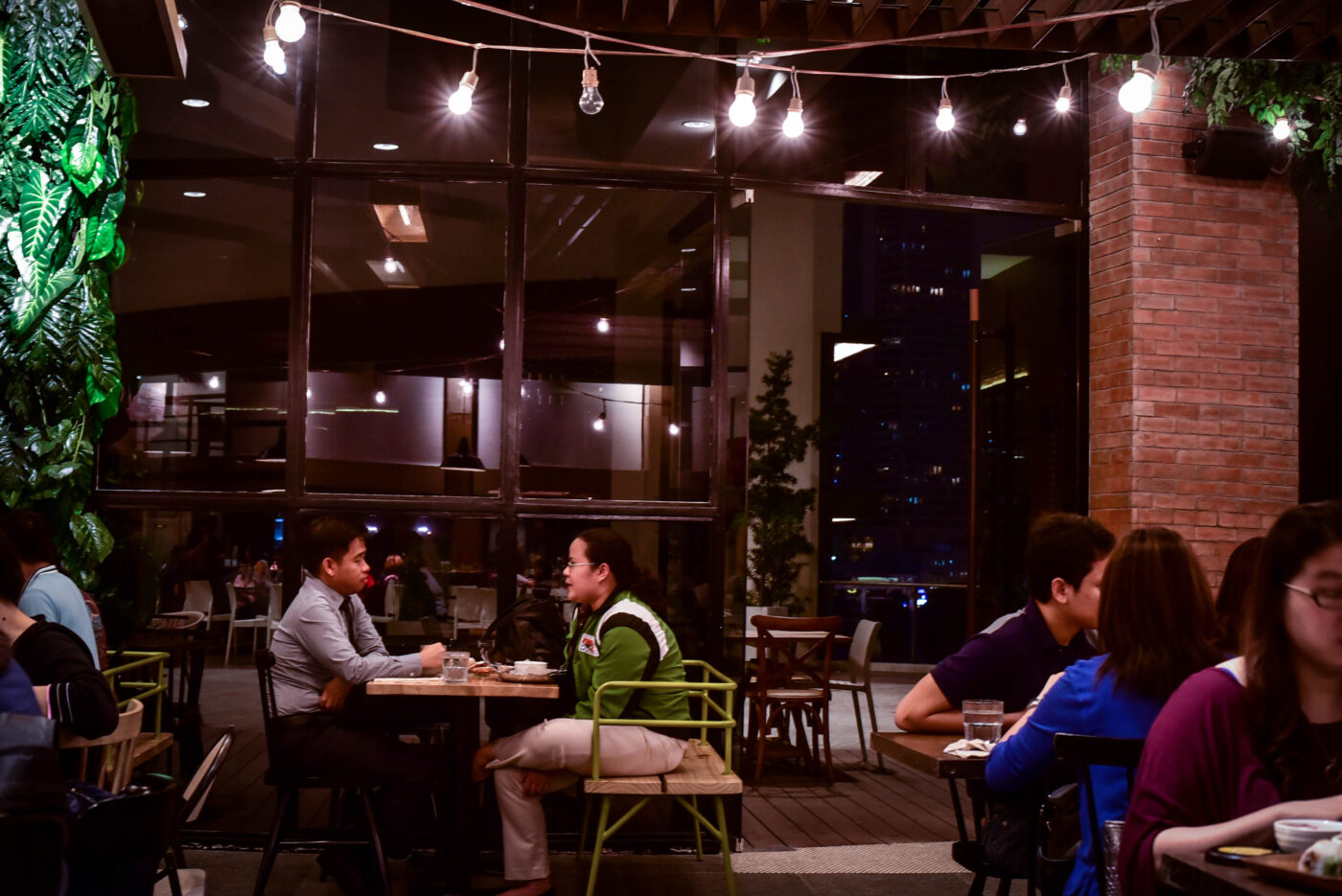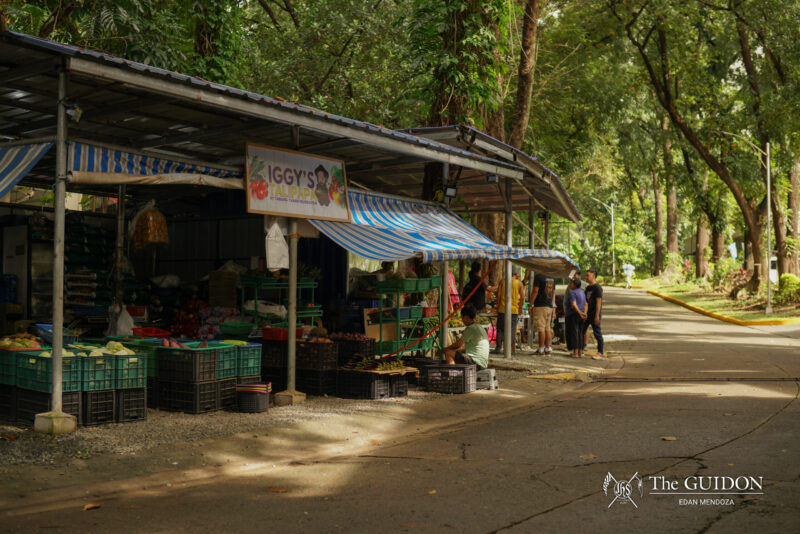A restaurant in the Philippines, if it is to have any chance of being popular, rests on the idea that it will offer something for everyone. Menus are made expansive and tables are made for large parties, because when Filipinos eat, they eat together. The idea of eating alone has never sat well in our culture of company, which is probably why the concept of communal dining has grown popular as of late.
When they aren’t open spaces, like the Z Compound on Malingap Street, communal food halls have high ceilings and are littered with independent food stalls, like Hole in the Wall in Century City Mall and Todd English Food Hall. A step away from the ordinary way Filipinos are usually served by restaurants, the current boom of communal dining holds plenty of promise for local businesses and beyond.
Hole in the Wall
The first thought one usually has upon entering Hole in the Wall is that it is a glorified food court for foodies who Instagram their meals before saying grace. Perhaps this reputation is well-deserved, given that the place is a melting pot of different cuisines. “It’s like traveling to different cities through eating,” says Jin Perez, the food writer behind the blog Jin Loves To Eat.
For the stall owners, it’s a whole different playing field. “I’m used to having time after a dish has been ordered, then cooking it straight from raw materials. But in a stall, once a dish is ordered, it has to be served in five minutes,” says chef JP Anglo, the owner of Liberation Shawarma. The stall offers condiments like Toum or Garlic Sauce, Shatta or Spicy Sauce and Anti-hot Sauce to accompany their Lebanese dishes.
Hole in the Wall also boasts of Scout’s Honor, owned by Chef Miko Aspiras. “Imagine your very own customized cookies freshly baked while you wait. Their Horlicks milk is wonderful, too,” shares Perez.
Customers can wash down their meals with a fresh glass of detox juice or craft beer—Spruce sells premium, cold-pressed juices like the Skinny Bitch, composed of pear, cucumber, pomelo, celery, romaine and parsley, while Mister Delicious serves Katipunan Craft Ales, such as the famous Indio Ale and Signal Number One Stout.
Since its opening, Hole in the Wall has become a hang out spot for people in Makati. “I think it brings a sense of togetherness. And since there [are] so many choices in one area, people are not limited to one type of cuisine or style of cooking,” says Anglo.
Perez explains that the food court is not a new concept in cities like Taipei, Hong Kong, Tokyo and Bangkok. She says that she is happy Manila is catching up, since people now want more choices when it comes to food. “Eating is not anymore just about the taste per se. It is also about interaction, multi-sensory pleasure, atmosphere and aesthetics. I believe Hole in the Wall has done an impressive job bringing the food court culture to Manila,” she adds.
Todd English Food Hall
For a franchise of a Boston-based international brand owned by a celebrity chef, the eponymous Todd English Food Hall has great personality. Much of it is care of the hands-on approach of their 100-person staff, led by Executive Chef Brett Halfpap and Managing Director Eric Dee.
Dee believed that the local market was craving “a newer, more sophisticated dining establishment,” and felt that importing Todd English would make it the first of its kind. “It’s 900 square meters of space with nine different stations,” says Dee, explaining the food hall format Todd English has taken. Towards the back of the restaurant is the sushi bar, where live oysters sit on ice and to the side is the charcuterie, where aged meats are displayed, and the wine and tapas bar. Towards the center is the communal dining area, which surrounds the well-stocked bar. “Essentially, it’s like running nine restaurants under one roof,” Dee adds.
Halfpap, who began as a 14-year-old dishwasher in his native Maryland before working his way to Jean-Georges’ kitchen in New York, describes Manila as a whole different ballgame for ingredients: “What is available and when it is available and whether or not we can get it—it’s difficult, but I like to experiment while I still have the opportunity.”
He talks of having to adjust to the Filipino palate (“They like things very sweet. I try to avoid that.”) but remains constant to principles of Todd English, whom he talks to every day. “We’re trying to change what is expected of food,” he says, when it comes to introducing new techniques. “You’re not going to make progress by not breaking the rules. So if we were going to make whole adjustments to make everything fit the Filipino palate, we wouldn’t be getting Todd English.”
Since moving to Manila in September 2014, Halfpap has noted that the most striking feature of the restaurant scene here is that “it’s very young. New York is very different—cutting-edge and new techniques. Things change very quickly. Here, it’s just beginning. It’s a great opportunity.”
When asked whether food halls are here to stay, Dee says simply, “Good food is good food. There is no denying [it], whether it be [from] a five-star hotel or a hawker cart on the streets of Vietnam.”
Z Compound
Aside from food trip-worthy Maginhawa, Malingap Street is another destination just around the corner. One of these is Z Compound, a simple garage-turned-food court that serves everything from Lebanese to Japanese cuisine.
Must-try dishes here include the authentic Lebanese shawarmas from Meshwe. They are known for their Chicken Shawarma Sandwich, which is grilled chicken shawarma with pickles, Arabic fries and garlic sauce wrapped in pita bread. The stall Bagneto, on the other hand, serves crispy bagnet in a rice bowl. Meanwhile, Bochic serves pulled pork sandwiches and Bochic popcorn or popcorn cooked in pig fat.
The garage was owned and developed by Eric Cadavillo to be an “incubator for the growth of aspiring young entrepreneurs wherein foodies can execute their ideas and not lose one shirt on his back in the process.” This place is not just for the hungry, but for the artsy as well. It holds sociocultural events such as poetry readings, book launches and street blues. When asked why he keeps this up, Cadavillo answers, “I can’t seem to find a better job that will suit my temperament and character.”
So how do the Z Compound’s stall owners stay successful? “The rent we are paying is really low. That’s the secret,” says Nathaniel Mounayer, the chef and owner of Meshwe. Cadavillo says that the rent that he passed on to his tenants was so reasonable they could not believe it during their first meeting. “I really want them to earn their return on what they’ve invested,” he explains.
Cadavillo is surprised by the reception Z Compound has been getting because his idea was simply affordability packed with choices. The mix of personalities and creative minds that joined all brought about the passion that breathed life into each establishment. “That pushed Z Compound and made it into an authentic hangout and foodie place,” he says.







